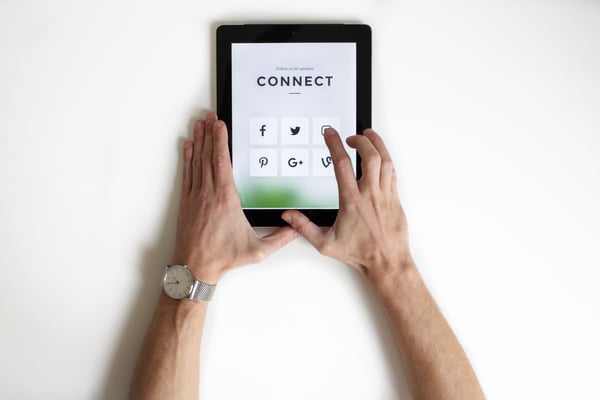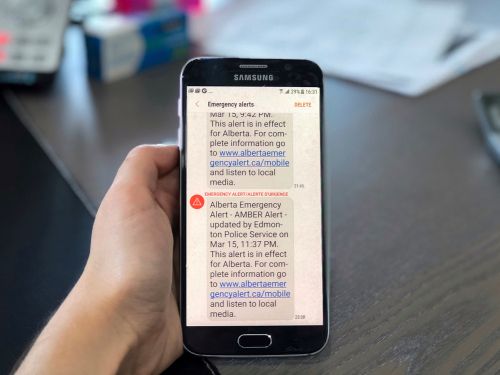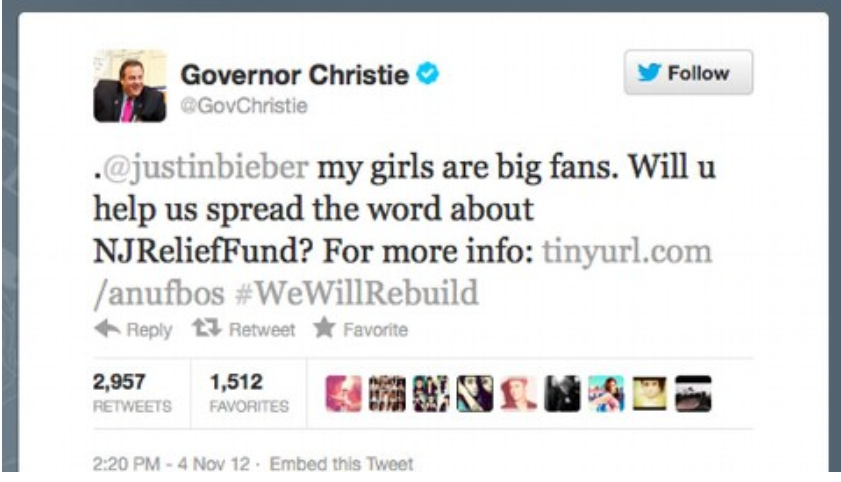Subscribe now and get the latest podcast releases delivered straight to your inbox.
6 ways social media can help for the greater good

Mar 5, 2020

“The no. 1 productivity killer.”
While marketers often benefit from it, that’s how many research studies and stats describe social media in today’s society and it’s far from a compliment.
People spend about two hours and 23 minutes a day on average scrolling through their Facebook, Instagram, and Twitter accounts, distracting them from other things and taking a questionable toll on their mental health.
It wouldn’t be fair, however, not to acknowledge that social media platforms have the potential to do a lot of good.
“Social media brings people together,” says IMPACT’s head of editorial content, Ramona Sukhraj. “...Friends, family, or even strangers who may become like the former.”
“With their huge — not to mention active — audiences, social media platforms form a global sounding board unlike any other today. They enable people from all walks of life and from all corners of the world to unite around common interests and share opinions.”
With this power, quick speed, and high accessibility, social media is an undeniable force that can be harnessed for the greater good.
Just think about Greta Thunberg.
The young Swedish climate activist has become an almost instant social media sensation, and she uses the medium to have her say on the state of our planet.
She’s influenced a global #howdareyou movement and openly speaks her mind, urging her millions of followers to do something before it’s too late.
Given that 45% of the world’s population uses social media on a daily basis, these platforms can be used to help people and promote good causes.
Here are six impressive ways it can (and has).
1. Generating awareness of causes

Back in 2014, not many people knew what the abbreviation ALS (amyotrophic lateral sclerosis) stood for, but then there was the Ice Bucket Challenge.
This viral campaign not only educated the world about ASL but also raised over $220 million worldwide for the research that would help people with this progressive neurodegenerative disease.
Would it be possible, however, to achieve something similar without social media?
Most likely, it wouldn’t.
Namely, it’s the instantaneous and interactive nature of Facebook, Twitter, and other platforms combined with the number of their users, that allow for the success of such campaigns.
Back in the day, when people relied on traditional marketing tools such as radio promotions, TV commercials, billboards, and print marketing, it took time for a message to reach the target audience and even more time for the audience to take action.
This entire promotional process lacked one crucial element – an accessible place where such an action could happen and gain momentum.
Social media provides us with all the necessary technical props that enable not only disseminating information but also a virtual space where people can gather, discuss, and be proactive.
Numerous groups and pages offer people from all over the world an opportunity to connect in real-time and share their opinions and ideas, just as if they were in the same room.
U.S. beauty giant Estee Lauder saw similar success to the Ice Bucket Challenge by marking the 20th anniversary of its first Breast Cancer Awareness Campaign with an interactive Facebook application that encouraged those who fought this battle to share their stories and motivational messages.
With the help of social media, this campaign, aptly named “20 Years of Courage: Past.Present.Future.” managed to connect all those who suffered from or were in any way touched by this disease, and helped them get in touch and learn from experiences of others.
Besides that, this campaign had a financial component. Every time somebody shared a post on the campaign’s interactive Facebook Timeline, $1 was donated to the Breast Cancer Research Foundation.
Worldwide Wildlife Fund masterfully leveraged Snapchat for its Last Selfie campaign in a similar way.
The ephemeral nature of this platform was a great vehicle for illustrating the bleak future of five endangered species – all of which were doomed to extinction and disappearance just like the self-destructing messages on Snapchat.
2. Uniting people during times of crisis
Due to its connectivity and emotional contagion, social media facilitates the spread of information at a great speed, while traditional communication channels tend to be far less efficient.

For marketers, this ability to bring people together is unmatched, but this power goes far beyond just selling products or building a brand.
For example, in certain cases, a quick reaction can make the difference between life and death.
Amber Alert, a system that assists in searching for missing children, heavily relies on social media shares in notifying and alarming the public about potential abductions for instance.
Facebook’s Safety Check tool takes advantage of this speed as well.
Safety Check was used for the first time in the wake of the April 2015 Nepal earthquake and allowed people from the affected area to mark themselves as safe so that their friends and families wouldn’t agonize until they heard from them.
Both of these examples capitalize on the wide reach and timely reactions and feedback that social media offers.
Without Facebook and Twitter, it would be virtually impossible to reach such a great number of people at the same time. Moreover, as posts about missing children receive a huge amount of shares, it increases the likelihood that they will reach a much wider audience than, say, an advertisement in a paper or TV news.
Similarly, disasters and crisis get immediate and on-the-spot coverage from multiple sources, thus allowing people who aren’t there to understand what is going on, react, or organize support.
3. Providing emergency disaster relief
Social media platforms can play an important role in providing emergency relief after natural or man-made disasters as well; being used to organize, coordinate, and deploy different rescue operations.
When a catastrophic earthquake hit Haiti in 2010, people from all around the world used social media to offer their support.
Those who wanted to donate reached out to charities on social media to ask where they can give their money and how exactly it would be used.
Twitter showed itself to be extremely powerful in this regard, as the network used the links that provided direct access to different fundraising and donating initiatives, instead of resorting to its usual policy of inviting new users to create new accounts first.
In fact, there were 2.3 million tweets between January 12th and January 14th mentioning the words “Haiti” or “Red Cross” aiding in this effort.
What’s interesting is that even CNN relied on tweets and social media posts in order to provide more information about everything that happened on the island, mainly because traditional lines of communication were down.
The Red Cross and FEMA also had great help from social media users during Hurricane Sandy, one of the worst storms in the mid-Atlantic area.
Statistics show more than 10 photos per second were uploaded to Instagram at the time, together with geotagged locations. This made it possible for the agencies to assess how to focus their efforts and plan their operations.
Even the Governor of New Jersey, Chris Christie, leveraged the influence of social media by tweeting and tagging celebrities such as Justin Bieber, as well as NY natives Bruce Springsteen and Danny deVito, to spread the word among their followers and help the affected area.

Furthermore, victims used social media tools to send messages for help, since phone lines and other means of communication were down.
Generally speaking, whenever an emergency occurs, social media is the best and most effective tool for galvanizing the general public into taking action.
It gives victims a voice and allows global audiences to see what’s really happening.
Shocking images and videos that emerge on social media after a disaster takes place spark empathy, while easily accessible ways to help, such as text-to-donation services, gain visibility by being reposted and shared millions of times.
Back in the day, people had to wait for reporters to reach the scene, while social media and cellular data usually can help people connect faster.
4. Stopping the spread of misinformation
Unfortunately, the power of social media platforms to spread the news and important information quickly also has its downsides.
There are people and organizations that take advantage of this to spread fake news and misinformation to big audiences.
The problem lies in the fact that even those who have a genuinely good intention end up spreading these lies and fake stories.
For instance, according to the latest reports, more than 70 countries resorted to spreading misinformation on social media in order to discredit their political opponents, influence foreign and domestic affairs, and control what they want the general public to believe to be true.
Luckily, today, it is possible for social media platforms to nip these inflammatory and deceptive narratives in the bud.
Facebook takes it particularly seriously.
The platform encourages users to report abusive or otherwise inappropriate content, pages, groups, or accounts that post such content then the support team reviews these reports and decides whether any further action will be taken.
This can result in removing the inappropriate content as well as suspend fake accounts and those that don’t comply with its Community Standards.
A York University staff member lost his job over what was perceived as an anti-Semitic post on Facebook, which the social media platform later removed.
Twitter has also had its fair share of fake news.
After the 2013 Boston Marathon bombings, different misinformation started swirling around, despite the micro-blogging platform attempts to correct these rumors.
The platform takes such incidents very seriously and has been working on finding a solution since.
As of March 2020, it will ban fake, manipulated, and doctored pictures and videos that pose a safety risk. In addition to that, certain tweets will be labeled as manipulated content and will contain a link to a page that provides more context.
Instagram, on the other hand, recently introduced a tool for labeling “fake information” that notifies users that a particular piece of content has been debunked by Facebook fact-checkers as false.
With this, the content is obscured and users have to click on the “See Post” button in order to view it.
Further, if someone attempts to share such content, they will be notified that it contains false or unconfirmed information together with a link to additional sources.
Hashtags related to anti-vaccine topics such as #vaccinescauseautism, for example, are now blocked as this information is under fire.
This is a solution that shows great potential to prevent misinformation and fake news from thriving. If things were left unattended, the credibility of social media would go down the drain.
Let’s not forget that the amount of time people spend on social media and the internet in general increases on an annual basis, meaning that a substantial part of our existence takes place online.
It’s only logical for this alternative, digital world to follow rules and regulations that will make it safer.
In a nutshell, if it weren’t for such regulatory attempts, social media would be at risk of becoming the place where people would be allowed to say and do things they would be punished for in the offline realm.
5. Preventing cyberbullying
Stats say that about 50% of adolescents and teens have been bullied online.
This “cyberbullying” is particularly challenging because victims can’t escape it even when they’re in the privacy of their own homes.
In some cases, this has led to PTSD, anxiety, depression, and even suicide.
However, platforms aren’t taking this lying down.
Just like in the case of the spread of misinformation, it’s possible to report a tweet, a list or a direct message, and flag it as abusive.
The platform permanently banned Milo Yiannopoulos, the alt-right writer, editor, and influencer, after he verbally abused comedian and actress Leslie Jones.
On Facebook’s end, they have created a bullying prevention hub together with the Yale Center for Emotional Intelligence in an attempt to help victims not only by taking down the problematic content but also by allowing them to interact with their abuser anonymously.
This tool reaches out to the bully, informs them that their content is embarrassing and hurtful, and shows them the consequences of their actions.
Overall, all these features help make social media platforms a safe space for everyone.
Given that online harassment and abuse don’t differ much from their offline counterparts in terms of the damage they can do to victims, it’s crucial to treat such incidents seriously.
It’s admirable and crucial that social media platforms recognize their role in these situations and take action to prevent them.
6. Helping people get support
While it’s true that social media still has to find more sophisticated ways of preventing and dealing with online abuse and bullying, it’s worth mentioning that these online channels can also help teens get support when faced with these issues.
As a matter of fact, a study has shown that 18% of teens say social media makes them feel better about themselves (as opposed to 4% who say worse). 25% of teens say it makes them feel less lonely, and 16% say that it makes them feel less depressed.
Although parents don’t exactly think that social media is good for their kids, the truth is that having a Facebook or Instagram isn’t all that bad. Of course, only when one is using these powerful communication channels properly.
It’s good for a teenager to be well-informed and connected with their community, and social media is a great way to achieve these goals.
Social media with all the support groups can help them cope, or at least vent about everything that bothers them.
They can benefit from joining teenage depression chats, sharing experiences with others, and reducing the feeling of isolation.
To further aid in the issues, Facebook has rolled out an AI-powered suicide prevention algorithm that scans posts in order to identify suicide risk.
Once a user’s behavior raises red flags, the platform reacts by sending out mental health resources, reaching out to the user’s friends, or even contacting local first responders.
Closing words
3.5 billion people use social media.
With this reach comes great power and with great power comes great responsibility.
No matter what we may think about social media platforms and their downsides, it’s evident that they can be a true game-changer in many critical situations.
By regulating the field as we move forward, it will be possible for both people and brands to enjoy the benefits of having such a gargantuan reach and spreading information quickly and effortlessly.
Marketers should be attuned to these changes of the platforms and what they say about the greater concerns of society and buyers and how they communicate.
Long term, all participants including brands are likely to be held more responsible for their words and actions, as that’s the only way to ensure that social media contributed to the greater good.


Order Your Copy of Marcus Sheridan's New Book — Endless Customers!